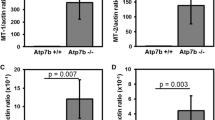ATOX1 is a cytoplasmic copper chaperone that interacts with the copper-binding domain of the membrane copper transporters ATP7A and ATP7B. ATOX1 has also been suggested to have a potential anti-oxidant activity. This study investigates the tissue-specific localization of the mouse homolog, Atox1, in mouse liver and kidney. Immunohistochemical studies in the liver localize the copper chaperone to hepatocytes surrounding both hepatic and central veins. In the kidney, Atox1 is localized to the cortex and the medulla. Cortex immunostaining is specific to glomeruli in both the juxtamedullary and cortical nephrons. Expression in the medulla appears to be associated with the loops of Henle. These data suggest that localized regions in the liver and kidney express Atox1 and have a role in copper homeostasis and/or anti-oxidant protection. Twenty-seven patients with Wilson disease-like phenotypes and two patients with Menkes disease-like phenotypes were screened for ATOX1 mutations with no alterations detected. The human phenotype resulting from mutations in ATOX1 remains unidentified.
Similar content being viewed by others
Author information
Authors and Affiliations
Rights and permissions
About this article
Cite this article
Moore, S., Helmle, K., Prat, L. et al. Tissue localization of the copper chaperone ATOX1 and its potential role in disease . Mamm Genome 13, 563–568 (2002). https://doi.org/10.1007/s00335-002-2172-9
Received:
Accepted:
Issue Date:
DOI: https://doi.org/10.1007/s00335-002-2172-9




